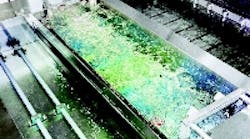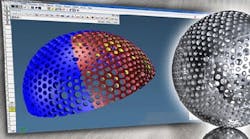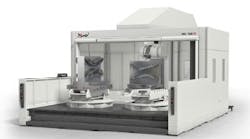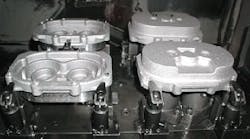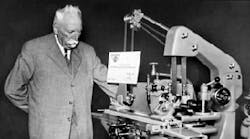Ultracleaning techniques for medical parts.
Parts loaded in dedicated baskets for ultrasonic processing get a cleaning boost from air agitation.
(Photo courtesy of Miraclean, Ashville, N.Y.)
Optimized exposure to ultrasonic energy requires rack and basket designs based on part geometries and surfaces to be cleaned. (Photo courtesy of Miraclean, Ashville, N.Y.)
Microblasting pinpoints an abrasive stream for selectively working parts, such as this surgical tool or pacemaker. (Photos courtesy of Comco Inc., Burbank, Calif.)
Medical-device manufacturers-worry a lot about cleanliness. Even minute contaminants left over from manufacturing processes can lead to far-reaching medical complications, as well as interfering with subsequent processes. To make matters worse, medical devices are shrinking and becoming more intricate, so achieving a high level of cleanliness is increasingly difficult, if not impossible, with traditional cleaning methods. Fortunately, several cleaning techniques — including ultrasonics, vacuum/pressure systems, microblasting, and plasma technology — are keeping pace with the stringent requirements of medical-device manufacturers.
Long a standard industrial-cleaning mainstay, vapor degreasing using chlorinated and fluorinated solvents is being replaced by environmentally friendly cleaning methods. However, substitute water-based, semiaqueous, and petroleum-based chemistries are often less effective than solvent cleaners, unless paired with a mechanicalenergy boost. Adding ultrasonic energy, for instance, speeds and enhances the performance of these alternate chemistries by creating microscopic bubbles that produce a scrubbing action to clean parts.
Ultrasonic, or cavitation, cleaning removes small particles, such as contaminants on medical devices, buffing compounds, and tiny chips from metalworking operations, from surfaces and inaccessible areas. It also cleans oxides from metal parts while reducing acid-chemistry use. Other applications include pretreating components for coating applications and cleaning electronic assemblies prior to finishing operations, valve bodies, transmission components, and injection molds.
Ultrasonic energy applied to a heated cleaning solution produces a 3D wave pattern of alternating positive and negative-pressure areas within a cleaning tank. Ultrasonic energy has frequencies above 18 kHz — beyond the limits of human audibility. Ultrasonic cleaning frequencies range from 20 to over 100 kHz, with most industrial-cleaning units operating at 20 to 50 kHz. Small tabletop ultrasonic cleaning units usually operate above 50 kHz.
At high amplitudes, negative pressures in the rarefaction areas of wave fronts fracture liquids and form cavitation bubbles. As the wave fronts pass, cavitation bubbles collapse and implode due to the higher pressures of the compression areas. Shock waves produced at the implosion sites of cavitation bubbles generate temperatures estimated at higher than 10,000° F and pressures greater than 10,000 psi. The implosion creates a pulsing/scrubbing action within the fluid to thoroughly clean devices without damaging their delicate features.
While cavitation is at the heart of ultrasonic systems, other important factors include type of detergent used, cleaning-fluid temperature, effectiveness of rinsing cycles, and part fixturing to eliminate nesting, masking, and potential air pockets. Sometimes additional types of mechanical action, such as rotation, agitation, and/or submerged sprays, are required to fully dislodge particles and contaminants or to reduce production times.
As a line-of-sight technology, ultrasonics have some limitations, particularly in reaching deep recesses and cleaning parts with extremely fine features. To overcome these limitations, a technique developed by HyperFlo, Gilbert, Ariz., uses vacuum/pressure technology to selectively grow bubbles.
The process first evacuates air in a chamber containing parts to be cleaned. Cleaning fluid then enters while parts are under vacuum, so the fluid intimately surrounds them. The vacuum also causes the fluid to boil and selectively forms bubbles on surface contaminants/particles for detachment.
Alternating vacuum and pressure produces a pulsing action within the fluid to generate bubbles that momentarily disturb the viscous surface. Fluid reintroduced into the surfaces then flushes away or dissolves detached contaminates and particles. The level of vacuum, pressure, temperature, and the rate of introducing vacuum and/or pressure control the growth rate and size of the bubbles and energy released.
"Surface imperfections are gently tormented by the cyclical growing and collapsing of bubbles," explains Charlotte Frederick, HyperFlo president. "Because pressures are omni-directional, dislodged contaminants or particles cannot relocate elsewhere. They are forcibly evicted and carried off."
Focused blasting
Unlike bead or grit blasters that use large volumes of air and media to produce a shotgun effect, microblasting pinpoints an abrasive stream for selectively working parts. The abrasive-mixture stream cleans, cuts, or deburrs parts, prepares surfaces, and removes materials. With microblasting, a metering device injects precise amounts of finely graded abrasives into a dry air stream. The air/ abrasive mixture travels through a small nozzle to accelerate and focus the stream.
In the manufacture of prosthetic hip assemblies, ball-joint assemblies, bone screws, dental implants, and similar devices, microblasting removes undesirable surface features that inhibit the body's acceptance of the device. It also abrades the implant surface with a finish conductive to tissue growth to anchor the implant.
For example, laser machining of medical implants, including stents and shunts, produces discoloration and oxidation of the base material and creates laser-slag deposits. The controllability and shockless nature of microabrasive blasting cleans such devices without deforming or damaging their intricate matrix shapes.
Basic microblasting systems consist of a blasters, nozzles, media, air dryers, workstations, and dust collectors. Two common types of blasters are small units for manual or intermittent use and large, more robust units for heavy production.
System nozzles come in a variety of shapes and sizes. For instance, some have right-angle openings to reach inside aircraft parts, and some are extended for deburring crossdrilled holes in machined parts.
The appropriate media for microblasting depends on the operation and workpiece material. Extremely dry and pure media for microblasting — ranging from soft sodium bicarbonate to hard silicon carbide — are different from those used in grit blasters, which cannot be used in microabrasive blasting. Moist air cannot be used in microabrasive blasting, so dessicant-type dryers are good for single-station installations, while membrane or continuous-duty versions are for multiple stations or operating multiple shifts/day.
In addition to containing spent media, illuminating workpieces, and creating a comfortable operator environment, workstations for microabrasive blasting must provide good air flow over workpieces for effective removal by industrial dust collectors.
Cleaning with plasma
Low-pressure plasma technology to modify and/or clean medicaldevice surfaces is a low-cost and environmentally friendly method of preparing them for bonding, deposition, and coating. It removes organic and inorganic materials without diminishing material bulk properties, consumes little energy, requires no drying, presents no waste-disposal issues, and accommodates an extensive range of substrates with almost any geometry.
Plasma is a partially ionized gas containing ions, electrons, atoms, and neutral species. The process of ionizing gases happens under vacuum. A high-frequency generator, which can be in the kHz, MHz, or microwave range, ionizes gases to create plasma. The resulting particles react with the outermost 10 to 1,000 Angstroms of a substrate.
Ultrafine cleaning of components, electronic assemblies, medical devices and consumables, connectors, and needles are typical plasmacleaning applications. With plasma treatment, surfaces outgas to completely remove contaminant films, even on complex surfaces.
Plasma removes nonvisible oil films, microscopic rust, and other contaminants that originate from stocking, previous manufacturing, or cleaning processes. It cleans injectionmolding additives, siliconebased compounds, release agents, and partially absorbed contaminants from plastics, metals, and ceramics.
